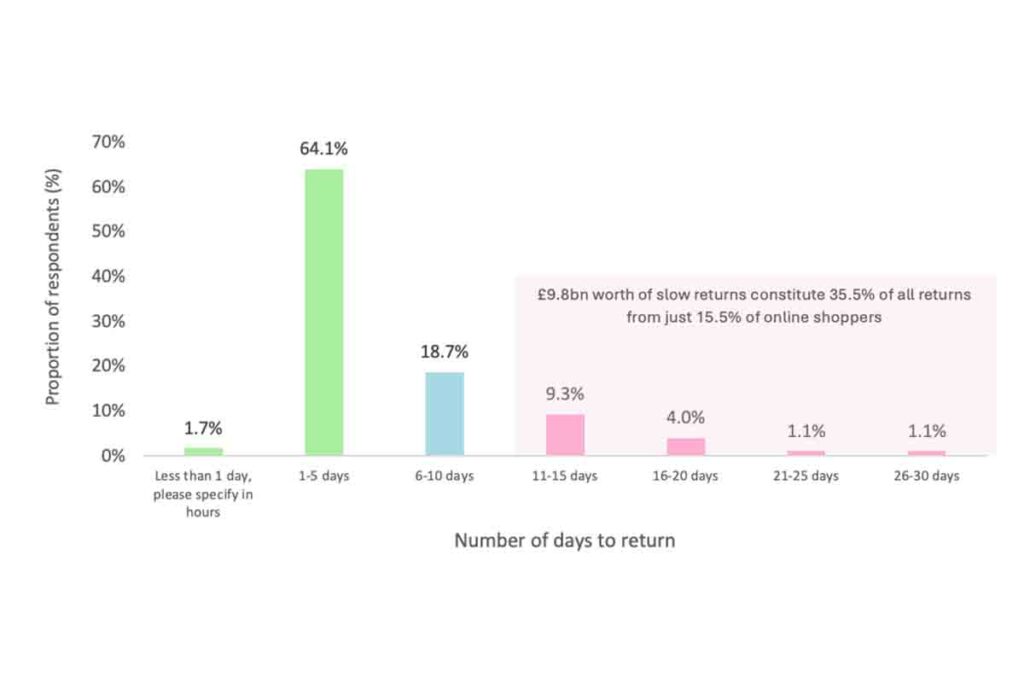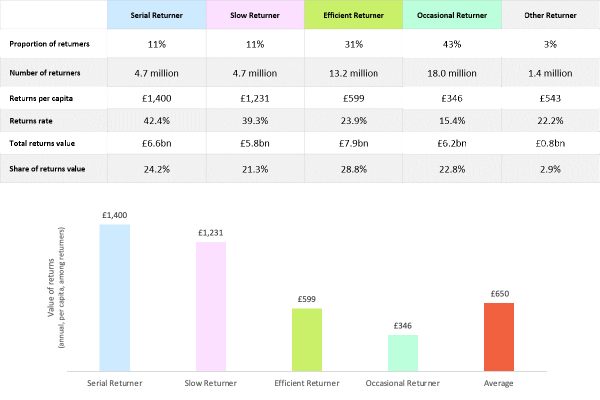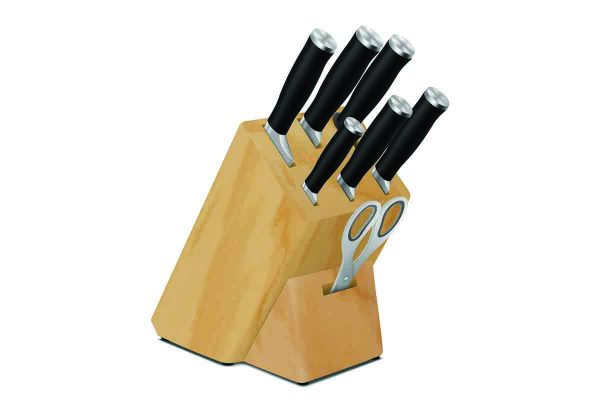As peak season approaches, a silent disruptor in the retail industry is emerging: slow returners. This group, who delay returning online purchases for extended periods, represent just 11% of all online shoppers yet are projected to account for £5.8bn – or 21% – of all online non-food returns in the UK in 2024. As uncovered in the Annual Shopper Research 2024 conducted by returns specialists ZigZag, in partnership with Retail Economics, the impact of this returner cohort will hit retailers hardest during peak season, when late returns can derail inventory management and cause bottom lines to plummet.
Slow returners are primarily younger consumers, with 75% being Gen Z or Millennials who shop predominantly online. Alongside serial returners, they generate a disproportionately high share of returns compared to the other cohorts (efficient returners and occasional returners). However, unlike their counterparts, slow returners prioritise convenience and exhibit impulsive buying behaviours often driven by buyer’s remorse. They tend to over-order, are highly price-sensitive and frequently delay returns, complicating retailers’ inventory management. In fact, slow returners are projected to send back an average of £1,231 worth of non-food products in 2024 – more than double efficient and convenient returners.
The speed at which consumers return goods is critical to reselling items at maximum value, especially during peak season shopping events like Black Friday. While around two-thirds of consumers return items within five days, 15.5% delay their returns by more than 10 days. This group is forecast to account for £9.8 billion in returns in 2024, making up over 35.5% of all returns. These delays pose significant risks for retailers, especially in fast-paced sectors like fashion, where item values decline if products miss peak sales periods during the returns process.
ZigZag’s Returns Secrets Exposed Report 2024 found that 42% of the top 130 UK retailers extended their returns policy window during peak. However, the financial risks posed by slow returners and the challenges of managing post-Black Friday inventory suggest that shorter return windows could provide a better opportunity to restock and resell goods.
Generational differences also affect return timings. Gen Z and Millennials take an average of seven days to return items, while Baby Boomers average within four days. Nearly half (46.9%) of Gen Z and Millennials place a high value on longer returns windows when selecting return methods for online orders. Whilst accommodating customer preferences is important, encouraging faster returns during Black Friday will help mitigate inventory risks and ensure products remain profitable during the peak season shopping frenzy.
Slow returners might seem more innocent than serial returners, but their behaviour will wreak just as much havoc if it continues to go unnoticed by retailers. Led by younger shoppers, this cohort is stretching out the returns process for retailers and severely increasing the chances of collecting unsellable stock. As we enter peak, when stock turnover is critical, retailers may struggle to resell returned items in time to meet seasonal demand. It’s crucial that retailers identify this cohort and tailor strategies to address the challenges head on. This might consist of incentivising shoppers that take more than 10 days to return items to process that return more quickly by offering discounts or seasonal offers. This can be achieved through more proactive communication via email or SMS.
We recommend retailers also offer the big five return options: post office, home collection, convenient drop-off locations like local shops, lockers, and if available, the retailer’s own store. By offering plenty of suitable carrier options, you can encourage fast returns from your customers whilst providing your business with greater flexibility during peak spikes or adverse weather.
– Al Gerrie, CEO, ZigZag
Profiting from returns
Different returner cohorts are not just using returns to reverse a purchase, but also as a way to make or save money. Slow returners exhibit profit-driven behaviours, with nearly a third (30.4%) delaying returns to benefit from rewards or cashback, often holding onto items for weeks to qualify for rebates. Additionally, just under a quarter (24.4%) of customers over-order to reach minimum spend thresholds, later returning part of the order.
The research also found that, on top of the trends seen with slow returners, nearly half (46.4%) of Gen Z and a third (35.3%) of Millennials chose a different payment method if they thought they might return an online order. This compares to just 5.5% among Baby Boomers. Payment methods include using digital wallets, buy now and pay later services, gift cards and credit cards when they might not have otherwise.
The data underscores a significant generational gap. Younger shoppers are more strategic in their use of alternative payment choices than older counterparts This is likely due to a greater familiarity with digital options, more convenience-focused habits and concerns over refund delays. We see similar patterns across regional hotspots. More than one third of consumers (37%) living in Greater London, 30% in Birmingham and 28% in Manchester engage in this activity compared to the nationwide average of just 24%.









